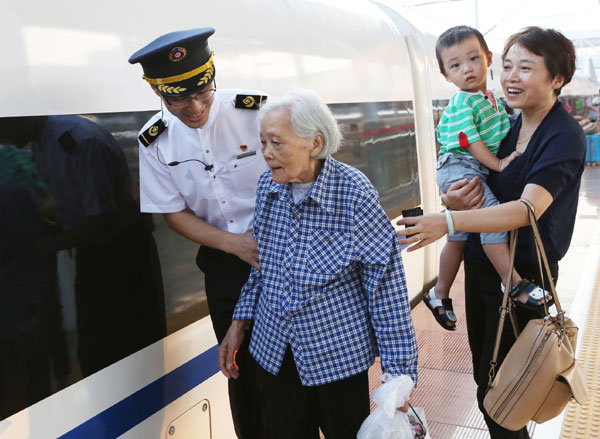High-speed rail keeps Guangxi growth on track
Updated: 2015-06-23 07:37
By HuoYan and XinDingding(China Daily)
|
||||||||
|
Passengers in Nanning taking a high-speed train for Beijing when the railway opened in September. Chen Fuping / for China Daily
|
Puffing on the platform
The frequent stops may annoy some passengers, but one group is eternally grateful. Smoking is banned in the trains, but the regular stops - which can last from two minutes to eight - mean heavy smokers flood out onto the platforms as soon as the train pulls up.
Zhou Xiang, who has worked on the new line since it was launched, has heard many smokers complain about how challenging they find the journey.
On slower trains, passengers can smoke in the door wells of the carriages, but smoking is banned everywhere on high-speed trains. According to the railway police in Nanning, 106 passengers were fined for smoking on the train last year.
"You can see them quickly lining up by the door when the train begins to slow down (for a stop). They always have a cigarette between their lips and a lighter in one hand. (They are) just like soldiers lining up with their weapons before going to the front," Zhou said.
Some of the more desperate smokers have even sparked arguments with the train attendants as they attempted to get out of the carriage as quickly as possible to make the most of each short stop.
On May 26, a passenger on train G529 tried to force the attendant to stand behind him so he could stand directly in front of the door and be the first passenger to disembark. His argument was "first come, first served", but he eventually relented when the attendant explained that she was duty bound to stand in front of the doors as the train comes to a halt to keep a watch for any obstructions or other activity on the platforms.
However, it's not just smokers who jump on and off the train. Five drivers work in relays during the long journey, said Wei Richun, a senior official at the Nanning Railway Bureau.
Just as safety regulations mean the working hours of commercial pilots are strictly regulated, with a team of two limited to 14 hours a day, drivers of high-speed trains are not allowed to be at the controls for more than three hours at a time, Wei said.
The drivers work for the four railway bureaus that administer the areas through which the train travels. A driver from the Beijing Railway Bureau is behind the wheel between Beijing and Zhengzhou in Henan, where another driver, this time from the Zhengzhou Railway Bureau, takes over until the train reaches Wuhan in Hubei province. The Wuhan Railway Bureau provides the next driver, who operates the train until Changsha in Hunnan province, when a driver sent by the bureau in Nanning takes over. He drives the train to Guilin in Guangxi, where a second driver is waiting to take the controls for the final leg of the journey to Nanning.
After resting for several hours in purpose-built apartment buildings, the drivers begin their journeys again, this time in the opposite direction, and return home.
While the drivers work short shifts, conductors and attendants such as Zhou have to stay at their posts throughout the entire journey, without taking a break.
"We feel under much greater pressure now than when we worked on the slower trains, because we used to work set times, and after an eight-hour stretch, we could take a break in our cabin. Now though, there's just no place or time to rest," he said.
The pressure is heightened by the fact that the assistants and guards have to deal with any emergencies that might arise on the high-speed trains, which each cost more than 100 million yuan ($16 million), he said.

 Liu visits Houston Museum of Natural Science
Liu visits Houston Museum of Natural Science
 Liu meets Tsinghua Youth team in Houston
Liu meets Tsinghua Youth team in Houston
 Men get into women's shoes for fun
Men get into women's shoes for fun
 Millions in harmony on Yoga Day
Millions in harmony on Yoga Day
 Liu visits CI in Pittsburgh
Liu visits CI in Pittsburgh
 Shenzhen Maker Week kicks off
Shenzhen Maker Week kicks off
 Chinese wrap up Zongzi to mark upcoming Dragon Boat Festival
Chinese wrap up Zongzi to mark upcoming Dragon Boat Festival
 A Chinese Garden in a Sister City
A Chinese Garden in a Sister City
Most Viewed
Editor's Picks

|

|

|

|

|

|
Today's Top News
Liu Yandong plays basketball diplomacy
Wang Yang hails S&ED
Tsinghua students flying high
Official underlines national defense technology innovation
New anti-corruption app sparks instant flood of public reports
Chinese Premier emboldens state firms' int'l industrial cooperation
CI in Pittsburgh welcomes
vice-premier
Sichuan and Pittsburgh unveil
new school
US Weekly

|

|








